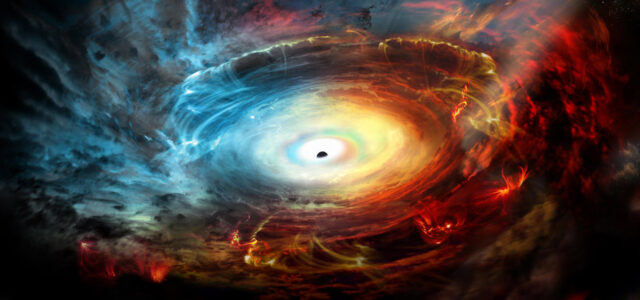Forecast: Cold downpours expected for giant black hole
Read time: 3 minutes
A giant black hole in a distant galaxy is in for some heavy rain storms. Using ALMA, astronomers have discovered giant clouds of cold gas that shower down on the black hole. An umbrella doesn’t help – it would need to be hundreds of light-years across.
Most distant galaxies have giant black holes in their cores. These supermassive black holes gobble up gas from their surroundings. When the galaxy is part of a cluster, there’s enough gas around: the space between the galaxies in a cluster is filled with extremely hot, tenuous gas.
Astronomers always believed that supermassive black holes would normally feast on this extremely hot gas in a slow, continuous way, as if there’s a steady trickle of hot gas falling from the sky. But ALMA has now discovered that supermassive black holes can also devour clumps of very cold gas in intermittent downpours, comparable to brief, intense rain showers.
In the central galaxy of a cluster known as Abell 2597, at about a billion light-years from the Earth, ALMA detected three clumps of cold gas, falling down at the supermassive black hole in the galaxy’s core. The clumps are a few tens of light-years across. Each is about a million times the mass of our Sun – heavy downpours for sure!
The cold clumps of gas are falling down toward the supermassive black hole at a speed of about 300 kilometers per second. Additional observations from the VLA radio observatory in the United States revealed that the clumps have already approached the black hole to a distance of some 300 light-years. They will arrive at the black hole in only a few hundred thousand years.
At the galaxy’s huge distance, the individual gas clumps would normally be hard to observe. even with ALMA’s impressive eyesight. They were discovered because they block some of the millimeter radiation that comes from energetic particles much closer to the black hole. In other words, ALMA saw the cold clouds silhouetted against the brighter background, just like you can see a dark rain cloud silhouetted against a bright sky on a hot summer day.
The true number of cold gas clumps raining down on the black hole is probably much larger – maybe a few thousand. It’s not entirely clear how the very hot gas in the space between galaxies can cool and condense into small clumps of much colder gas. But apparently, the downpour of gas onto a supermassive black hole can sometimes be much more chaotic than previously thought.
What?

Abell 2597 is a small cluster of a few dozen galaxies, at a distance of about one billion light-years in the constellation Aquarius, the Water Bearer. The central galaxy in the cluster harbors a giant black hole in its core that weighs in at about 300 million times the mass of our Sun. Hot gas surrounding the galaxy had earlier been observed by NASA’s Chandra X-ray Observatory. Now, ALMA has also detected small clumps of much colder gas that rain down on the supermassive black hole.
Who?
The discovery of the small clumps of cold gas that rain down onto the supermassive black hole in the central galaxy of the cluster Abell 2597 was made by a very large, international team of astronomers. The team was led by Grant Tremblay of Yale University in New Haven, Connecticut. The discovery has been published in the weekly science magazine Nature.

ALMA URL


